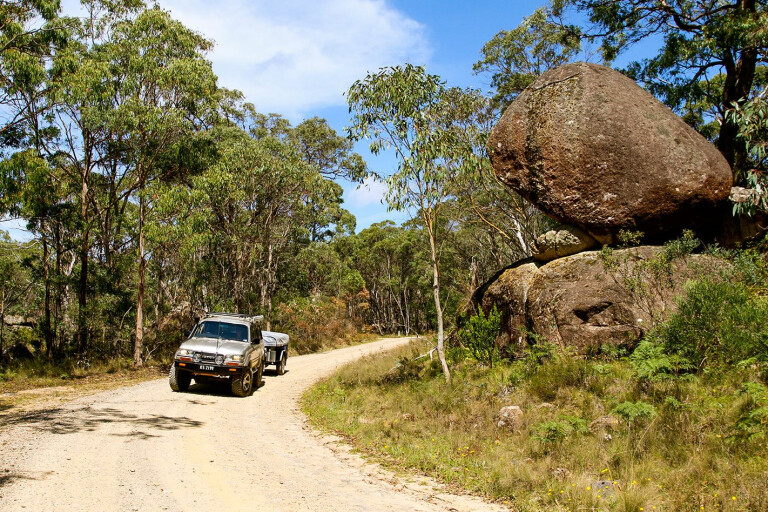
Sometimes we get so hung up on the big trips, like those to Cape York, the Kimberley or even the Simpson Desert, we forget about the little beauties in our backyard.
On the doorstep of New South Wales’ north coast are many popular beach-side destinations to explore, but why not head the other way – west of Coffs Harbour, into the heart of NSW’s New England region?
There are several national parks in the area, and few are as surprisingly good as Cathedral Rock National Park. A relatively small park of about 89km², it’s not as well-known as some others, but it’s certainly worth the drive.
 The only vehicle entry into the park is 65km east of Armidale, towards the Ebor Volcano. The 8km road into the centre of the park passes through several properties and is irregularly maintained, so be prepared for corrugations and the occasional washaway. Also, keep your eyes on the ecosystem, which transforms as the road snakes around huge granite boulders – lush green paddocks will become low heathlands among dry scrub with impressive granite formations above.
The only vehicle entry into the park is 65km east of Armidale, towards the Ebor Volcano. The 8km road into the centre of the park passes through several properties and is irregularly maintained, so be prepared for corrugations and the occasional washaway. Also, keep your eyes on the ecosystem, which transforms as the road snakes around huge granite boulders – lush green paddocks will become low heathlands among dry scrub with impressive granite formations above.
It won’t be long before you enter Barokee Campground, which caters for day trippers, those who want to explore the park and those with camper trailers or tents. Facilities here are limited, with only one pit toilet, some fire places and several picnic tables offered. Firewood is often provided but don’t count on it.
 After setting up camp and paying your fees to the campground honesty box, you can start to explore by taking a three-hour hike to Cathedral Rock. For those with at least medium-level fitness, this walk will pass through fern-filled heathlands beside several creeks before winding through granite boulders.
After setting up camp and paying your fees to the campground honesty box, you can start to explore by taking a three-hour hike to Cathedral Rock. For those with at least medium-level fitness, this walk will pass through fern-filled heathlands beside several creeks before winding through granite boulders.
Most people will find the walk easy until the final 400m climb towards the top of the rock formations. While the track is pretty informal, you’ll need to follow the arrows that lead to the top. However, take care, as the arrows are a fair distance apart through some sections.
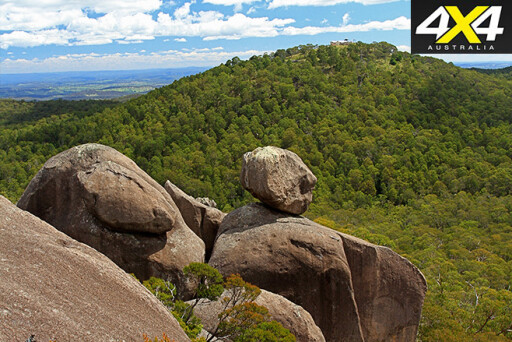 When you reach the summit the sights are stunning, with 360-degree views across the valley below and across to other granite tors (free-standing rock formations) in the distance. You’re on a break, so sit here for an hour and soak up how peaceful it is. At 1550m above sea level, the views are terrific.
When you reach the summit the sights are stunning, with 360-degree views across the valley below and across to other granite tors (free-standing rock formations) in the distance. You’re on a break, so sit here for an hour and soak up how peaceful it is. At 1550m above sea level, the views are terrific.
After the scramble back down to the main walking trail, the track will lead you around the base of the granite boulders and back to camp. Along the way, you’ll pass the intersection for the 10.5km walk to the Native Dog campground, situated on the northern side of the park. It’s interesting to see that the granite formations are only found within Cathedral Rock National Park.
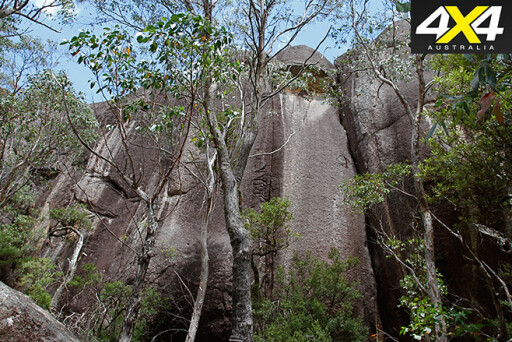 Back at camp you’ll see plenty of birdlife and wallabies minding their own business as they feed nearby. To keep less likeable animals (vermin) to a minimum there are no bins in the park, so as with any similar campground, take your rubbish with you.
Back at camp you’ll see plenty of birdlife and wallabies minding their own business as they feed nearby. To keep less likeable animals (vermin) to a minimum there are no bins in the park, so as with any similar campground, take your rubbish with you.
After a crisp, cool night’s sleep, you can head back out of the park to Point Lookout, one of the highest outside of the Snowy/Kosciuszko region, around 1000km to the south. From here it’s possible to see remnants of the rim of Ebor Volcano, which was active about 30 million years ago.
Heading west towards Armidale, you’ll find a turn-off that will lead you to the lookout. The 14km dirt road to the lookout passes through a diverse range of plant types, from rich pastures on the plateau to thick pockets of rainforest. As you climb higher, moss-covered snow gums appear.
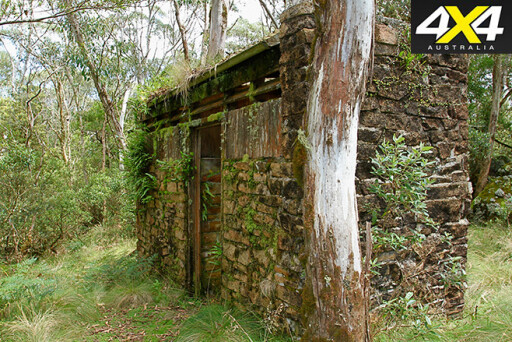 Then, heading towards the lookout, you’ll enter the New England National Park, where it’s possible to hire cabins near the summit of Point Lookout. This is a great option for those who wish to spend their time exploring nearby walking trails, or those who want an alternative to tent camping in winter – temperatures are consistently below freezing here in the winter months.
Then, heading towards the lookout, you’ll enter the New England National Park, where it’s possible to hire cabins near the summit of Point Lookout. This is a great option for those who wish to spend their time exploring nearby walking trails, or those who want an alternative to tent camping in winter – temperatures are consistently below freezing here in the winter months.
At the summit of Point Lookout, the NSW National Parks and Wildlife Service (NPWS) has implemented some worthwhile features. There are lookouts, walking trails that have been graded for different fitness levels, an information shelter with a barbecue, picnic areas, and a preserved, historic rock cairn.
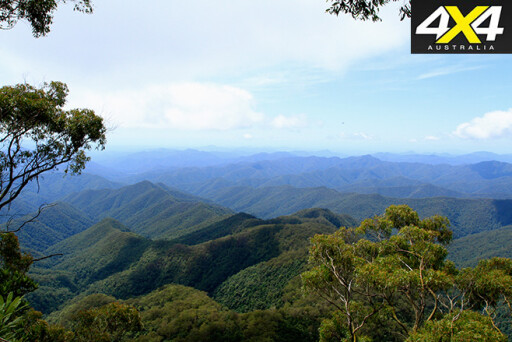 The most common trek from here is a 20-minute walk that grants views of Ebor Volcano’s outer rim remnants. This volcano was last active 30 million years ago, so don’t expect to see the top of the rim glowing! After 30 million years of weathering, it’s amazing you can still see the 300m-thick rim down in the wilderness.
The most common trek from here is a 20-minute walk that grants views of Ebor Volcano’s outer rim remnants. This volcano was last active 30 million years ago, so don’t expect to see the top of the rim glowing! After 30 million years of weathering, it’s amazing you can still see the 300m-thick rim down in the wilderness.
The views from Point Lookout down through the valleys and into the wilderness are nothing short of breathtaking. A great tip is to arrive in the afternoon when the sun is to the west (behind you) and it’s possible to see the blue of the ocean down in the distance. You’ll also be able to appreciate just how rugged the landscape is below you. This is what it feels like to be on top of the world, even if it’s only for a short time. And to think all of this is only 140km from the hustle and bustle of the tourist coastal strip!
EBOR VOLCANO
Before man walked the earth, the NSW coast was alive with volcanic eruptions. One significant volcano was near Ebor, 65km east of Armidale on the state’s mid-north coast. It’s been estimated the Ebor Volcano was very active 30-60 million years ago.
The lava-flows from this volcano extend for several hundred kilometres around it to such areas as the Barrington Tops and Mount Kaputar. This is evidenced by the rich-red farming land the NSW mid-north coast is known for. There are floodplains to the west, where the basalt soils are black. From the potato-growing area near Dorrigo to the lush sub-tropical rainforest areas that run along and meet the coast to the north and to the south, this is known as Gondwanaland.
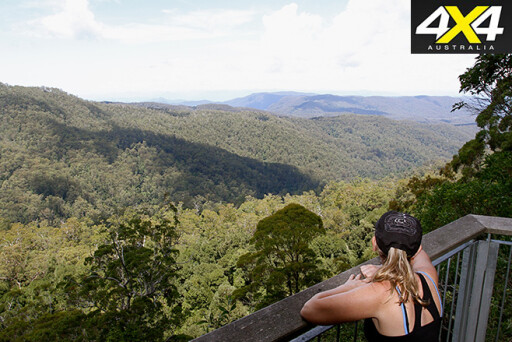 The New England NP, which surrounds the volcano, plays a significant part in the protection of a wide diversity of plants and animals. This was recognised in the late 1980s and was listed as a World Heritage area.
The New England NP, which surrounds the volcano, plays a significant part in the protection of a wide diversity of plants and animals. This was recognised in the late 1980s and was listed as a World Heritage area.
Ebor Volcano’s 300m-thick rim can be viewed from Point Lookout, which is 1565m above sea level. The lookout provides stunning views into the wilderness areas that surround the rim, and at this high altitude you can see cold, tolerant snow gums covered in thick moss.
TRAVEL PLANNER
WHERE
Cathedral Rock National Park is on the New England Tableland: 560km north of Sydney, 400km south of Brisbane and 60km east of Armidale, NSW. The surrounding parks are accessible from Waterfall Way, which runs between Armidale and the coast.
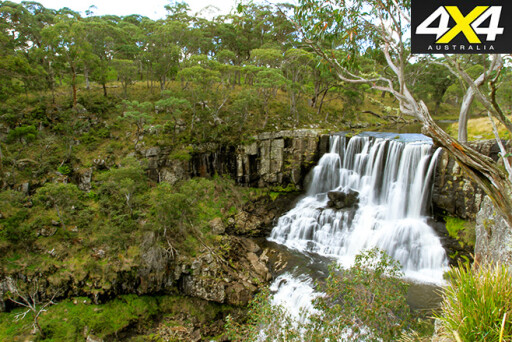 CAMPING
CAMPING
Cathedral Rock NP has two camping areas available: Barokee and Native Dog. Barokee campground is 8km into the park. Its sites are great for tents and camper trailers, but caravans are advised to use the Native Dog rest area because of the narrow access road and lack of turning bays at the campground.
The Native Dog rest area is situated on the northern side of Cathedral Rock NP, along a 1km access road. This campground is suitable for tents, camper trailers and caravans. Facilities at both campsites include pit toilets, several picnic tables and wood barbecues with firewood provided by NPWS.
Fees are payable via an honesty system at the information board at each campground. Camping fees are $5 per adult and $3 per child per night. No bookings required.
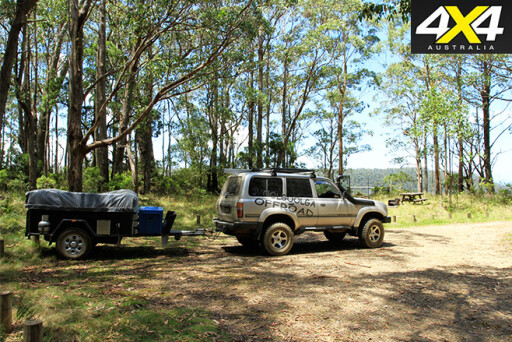 WHAT TO TAKE
WHAT TO TAKE
You need to be totally self-sufficient at either campground, with your own food and water. Several streams flow through the park and water points are signposted by NPWS for collection of water. It’s best to boil any water for at least three minutes before drinking.
SUPPLIES AND FACILITIES
An advantage for families spending several days on the New England Tableland is that supplies are not far away. Armidale, a major regional town, is only 60km away if you need extra supplies. For smaller items, the hamlet of Ebor is a 10-minute drive away. Ebor has very limited facilities, so be prepared. Phone service is available with the main carriers in most locations in the park.
TRIP STANDARD
The main road into Cathedral Rock is an 8km unsealed road. It is irregularly maintained, so be prepared for corrugations and a few potholes. As always on dirt roads, select 4WD.
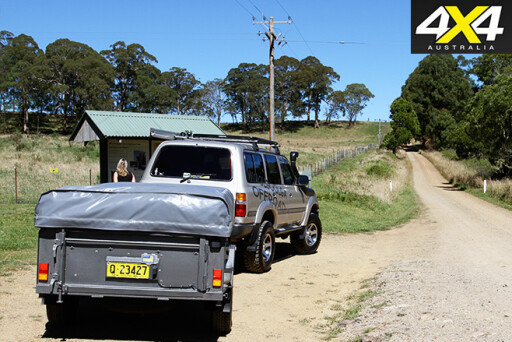 CONTACTS AND INFORMATION
CONTACTS AND INFORMATION
For more information on the Cathedral Rock or New England national parks, contact the Dorrigo Rainforest Centre on (02) 6657 2309, or visit NSW Office of Environment & Heritage. The Rainforest Centre has a range of maps, PDF files and offers information on local weather and road conditions.
PERMITS AND MAPS
The standard national park daily vehicle entry fee of $7 applies if you are visiting any of the parks in the area. This is payable at either the Dorrigo Rainforest Centre or at the information boards located within the park.

COMMENTS